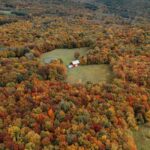Growing grass and plants under trees can be a challenging task for any garden enthusiast. The shade from the tree canopy, competition for water and nutrients, and the accumulation of leaf litter make it difficult for plants to thrive. However, with a little bit of knowledge and effort, it is possible to create a beautiful garden even in the shade of trees.
In this article, we will explore the various factors that affect plant growth under trees and provide practical tips on how to grow grass and plants successfully. We will discuss soil preparation, selecting appropriate plants, watering techniques, pruning practices, and other essential considerations for creating a thriving garden under the shade of trees. Whether you are an experienced gardener or just starting out, this guide will provide you with valuable insights that will help you enhance your gardening skills and create a beautiful space that you can enjoy year-round.
Understanding The Challenges Of Gardening Under Trees
Imagine a forest as a bustling metropolis, with towering trees reaching high into the sky, blocking out sunlight and creating shade. Underneath this canopy lies a complex ecosystem, where plants must compete for resources in order to thrive. Gardening under trees can be just as challenging, but with the right knowledge and techniques, it is possible to create a thriving garden.
One of the first challenges to consider when gardening under trees is tree species selection. Different tree species have varying root systems that can affect soil moisture levels and nutrient availability. For example, shallow-rooted trees such as maples can quickly absorb water and nutrients from the topsoil, leaving little for other plants to utilize. On the other hand, deep-rooted trees such as oaks have roots that penetrate deeper into the soil, making it easier for plants to access water and nutrients.
Another important factor to consider is soil pH. Trees naturally lower soil pH levels over time through the buildup of organic matter and acidic substances in their fallen leaves and branches. This can make it difficult for certain plants to grow if they require neutral or alkaline soil conditions. It is important to test your soil pH regularly and amend it as needed to create an environment that is conducive to plant growth.
Assessing your tree canopy and shade levels is an essential step in successfully gardening under trees. Shade-tolerant plants should be selected based on how much sunlight they need each day. Some plants can tolerate full shade while others may require partial sunlight throughout the day. Understanding your specific site conditions will allow you to select appropriate plant species that will thrive in your garden space without competing with your existing tree ecosystem.
Assessing Your Tree Canopy And Shade Levels
Before attempting to grow plants or grass under trees, you should first assess your tree canopy and shade levels. The amount of sunlight exposure that your plants receive will be a determining factor in their growth and vitality. Trees with large canopies will block out more light than smaller ones, while the density of the foliage will also affect light penetration.
Additionally, understanding root competition is essential when planting under trees. Tree roots can extend far beyond the canopy of the tree, competing with new plants for nutrients and moisture. It’s important to choose plants whose roots won’t compete with those of the tree for resources. This means avoiding shallow-rooted species that would struggle to survive in such conditions.
By assessing your tree canopy and shade levels, as well as understanding root competition, you’ll be able to choose appropriate plant species and placement to ensure successful growth. In the next section, we’ll discuss how to prepare your soil for plant growth under trees by taking into account the unique challenges of this environment.
Preparing Your Soil For Plant Growth
- Testing the pH of the soil is critical for successful plant growth, as most plants prefer a slightly acidic environment.
- Adding organic matter to the soil can help improve the soil quality, increase water retention and fertility, and provide essential nutrients for plant growth.
- When growing plants in the shade of trees, it is important to choose plants that are suitable for low light conditions and are tolerant of the root competition.
- Different plants have different requirements when it comes to pH levels, so it is important to test the soil before planting to ensure the desired plants will thrive.
- Organic matter can be added to the soil in the form of compost or manure, which helps to improve the soil structure and increase the soil’s fertility.
- Shade tolerant plants such as ferns, hostas, and impatiens are ideal for planting under trees as they can thrive in low light conditions.
Testing Soil Ph
Measuring acidity in soil is an essential step in preparing your soil for plant growth. Soil pH measures the acidity or alkalinity of soil, and it’s measured on a scale of 0 to 14, with 7 being neutral. Most plants prefer a slightly acidic soil with a pH range between 6 and 7.5. Testing the pH level of your soil will help you understand what amendments or adjustments, if any, need to be made.
To measure soil pH, you can use a soil test kit or send a sample to a laboratory for analysis. Soil test kits come with test strips that change color when exposed to the soil’s pH level. The results are then compared to a chart that indicates the corresponding pH level. Laboratories use more accurate methods such as electronic meters or chemical tests that provide detailed information about nutrient levels and other factors in addition to the pH level.
Adjusting soil pH is crucial for promoting healthy plant growth. If your soil is too acidic or alkaline, it can affect nutrient uptake, root development, and overall plant health. Lime can be added to acidic soils to raise their pH levels, while sulfur can be used to lower high alkaline levels. It’s essential not only to know how much lime or sulfur needs to be added but also when and how often they should be applied.
In conclusion, testing soil pH is an important step in preparing your soil for plant growth since it allows you to determine if any adjustments need to be made before planting. Measuring acidity can be done using a variety of tools like test kits or laboratory analysis that give detailed information about nutrient levels and other factors affecting plant growth besides pH levels. Adjusting the soil’s pH is necessary for promoting healthy plant growth by ensuring proper nutrient uptake and root development through adding lime or sulfur as needed based on the results obtained from measuring acidity in the first place.
Adding Organic Matter
A crucial step in preparing your soil for plant growth is adding organic matter. Building compost and adding manure are two ways of increasing the organic content of your soil. Organic matter improves soil structure, increases moisture retention, and provides essential nutrients to plants. It also helps to attract beneficial microorganisms that promote healthy plant growth.
Building compost involves creating a mixture of organic materials such as leaves, grass clippings, vegetable scraps, and other yard waste. The compost pile needs to be turned regularly to ensure even decomposition, and it can take several months to a year for the compost to be ready for use in your garden. Adding manure is another way of increasing the organic content of your soil; however, it’s essential to use aged or composted manure since fresh manure can burn young plants.
Both building compost and adding aged or composted manure will improve the quality of your soil by increasing its organic content. These actions enhance the soil’s ability to retain moisture and nutrients while promoting healthy root development. In addition, they provide an environmentally friendly way of disposing of yard waste while improving the fertility of your garden soil.
Choosing Plants Suitable For Shade
As a horticulturalist, one of the essential aspects to consider when preparing your soil for plant growth is choosing plants suitable for shade. Planting techniques and maintenance tips are crucial in selecting the right plants that can thrive in less sunlight. Shade-tolerant plants have adapted to low light conditions by using their leaves to capture as much light as possible, making them ideal for planting in areas with less exposure to sunlight.
When choosing plants suitable for shade, it’s important to consider their growth habits and requirements. Some plants prefer dappled shade or partial sun, while others can tolerate deep shade. Ferns, hostas, and astilbes are some examples of popular shade-loving plants. These plants require moist soil and good drainage; therefore, incorporating organic matter into your soil will provide the necessary nutrients required for healthy growth.
Maintenance tips are also essential when growing shade-tolerant plants. Regular watering is necessary since water retention is often lower in shaded areas due to reduced evaporation rates. Mulching around the base of the plant also helps retain moisture while keeping weeds at bay. By following these planting techniques and maintenance tips, you can ensure that your garden thrives even in areas with less sunlight.
Choosing The Right Plants For Your Garden
After preparing your soil for plant growth, the next step is to select the right plants for your garden. However, growing grass and plants under trees can be challenging due to several factors such as shade, competition for nutrients and water, and limited sunlight. But with proper plant selection and soil preparation, you can create a lush garden under your trees.
Plant selection is crucial when it comes to growing plants under trees. You should choose shade-tolerant plants that can thrive in low-light conditions. Some of the best plants for this environment include hostas, ferns, heucheras, and pulmonarias. These plants are known for their ability to grow in shaded areas without requiring much sunlight.
Soil preparation is also vital when growing grass and plants under trees. You need to amend the soil with organic matter such as compost or aged manure to improve its fertility and drainage. This will help your plants establish themselves better and compete with tree roots for nutrients and water. Additionally, mulching around your plants will help retain moisture in the soil while suppressing weed growth.
Incorporating groundcovers and mulch is an effective way of maintaining a healthy garden under trees. Groundcovers such as creeping phlox or vinca minor provide excellent coverage while also preventing soil erosion. On the other hand, mulch helps regulate soil temperature and moisture levels while providing a protective layer against weed growth. With these tips in mind, you can create a beautiful garden under your trees that thrives all year round!
Incorporating Groundcovers And Mulch
- When choosing the right groundcover for underneath a tree, it is important to consider the size and shape of the space available, as well as the type of tree and its root system.
- The soil underneath the tree should be loosened and amended with organic matter before planting to ensure good drainage and adequate oxygen levels to the roots.
- Applying a layer of mulch helps to retain soil moisture and nutrients, while also suppressing weed growth.
- A mulch layer should be spread around the tree to a depth of at least 2 to 3 inches and should be replenished as needed.
- When planting groundcovers, it is important to select plants that are hardy and tolerant of the tree’s shade and root competition.
- An ideal groundcover should be able to spread quickly, be low maintenance, and still look attractive.
Choosing The Right Groundcover
As a horticulturalist, I understand the frustration of trying to grow grass and plants under trees. However, choosing the right groundcover can make all the difference in creating a healthy and thriving landscape. There are several groundcover options available, but it’s important to choose one that can tolerate shade and compete with tree roots for nutrients.
Best practices for choosing a groundcover include considering factors such as soil type, moisture levels, and amount of sunlight. Some popular options for shady areas include creeping juniper, pachysandra, and vinca minor. These plants not only add aesthetic appeal to your landscape but also provide functional benefits such as reducing erosion and suppressing weed growth.
Incorporating the right groundcover can improve the health of your lawn and plants while also adding visual interest to your landscape. When selecting a groundcover option, be sure to consider its maintenance requirements and compatibility with other plants in the area. By following these best practices, you can successfully create a lush landscape under your trees without sacrificing their health.
Preparing The Soil For Planting
As a horticulturalist, incorporating groundcovers and mulch is an essential part of maintaining a healthy landscape. However, before planting any groundcover, it’s important to prepare the soil properly. One crucial step in preparing the soil is amending it with organic matter such as compost or aged manure. This helps improve soil structure and fertility, allowing plants to grow strong roots and thrive.
Another critical factor to consider when preparing soil for planting is soil pH management. Different plants require different soil pH levels to grow optimally, so it’s important to test the soil’s pH and adjust it accordingly. Most groundcovers prefer slightly acidic soil with a pH range of 5.5 to 6.5. If the soil is too acidic or alkaline, adding lime or sulfur can help balance the pH level.
Preparing the soil for planting not only improves plant growth but also enhances the overall health of your landscape. By amending the soil with organic matter and managing its pH level, you can create an ideal environment for your groundcovers to thrive while also reducing maintenance requirements in the long run. With these best practices in mind, you can successfully incorporate groundcovers and mulch into your landscape while serving others by creating a beautiful and sustainable outdoor space.
Applying Mulch For Nutrient Retention
Incorporating groundcovers and mulch is an essential part of maintaining a healthy landscape. Once the soil has been properly prepared, applying mulch is the next step in ensuring that your plants thrive. Mulching benefits include retaining moisture, suppressing weed growth, and regulating soil temperature. There are two types of mulch: organic and inorganic. Organic mulches such as wood chips or leaves decompose over time, adding nutrients to the soil. Inorganic mulches such as gravel or rocks do not break down but still provide many benefits.
When applying mulch, it’s important to apply it correctly to maximize its benefits. The recommended depth for most organic mulches is 2-3 inches, while inorganic mulches can be slightly thinner at around 1-2 inches. Be careful not to pile too much mulch against the base of plants, as this can cause stem rot and other issues.
In summary, incorporating groundcovers and mulch into your landscape provides numerous benefits for both plant growth and overall health. By choosing the right type of mulch and applying it correctly, you can retain nutrients in the soil while reducing maintenance requirements in the long run. With these best practices in mind, you can create a beautiful and sustainable outdoor space that serves others well.
Proper Watering Techniques
Watering is an essential aspect of plant growth, especially when it comes to growing plants under trees. The frequency of watering should be determined by the soil moisture management. It’s important to avoid overwatering as well as underwatering. Overwatering can lead to root rot while underwatering can cause wilting and stunted growth in plants.
The best way to determine when to water your plants is by checking the soil moisture level regularly. Stick a finger into the soil about an inch deep and if it feels dry, then it’s time to water your plants. On the other hand, if the soil feels moist or cool, then you should hold off on watering until the topsoil feels somewhat dry.
Proper watering techniques are crucial for plant growth under trees. By monitoring watering frequency and managing soil moisture levels, you can ensure that your plants thrive in their environment. In the next section, we will discuss fertilizing your plants for optimal growth and how it plays an important role in enhancing plant health and vigor.
Fertilizing Your Plants For Optimal Growth
Proper watering techniques are key to the growth and survival of plants, especially when attempting to grow them under trees. However, it is equally important to fertilize your plants for optimal growth. Fertilizers provide essential nutrients that plants need to thrive, and there are different types of fertilizers available on the market.
Organic vs chemical fertilizers: Organic fertilizers are made from natural materials such as compost, manure, and bone meal. They release nutrients slowly over time and improve the soil structure, which helps with water retention. Chemical fertilizers are made from synthetic chemicals and release nutrients quickly. While they can be effective in providing a quick boost of nutrients, they can also harm beneficial microorganisms in the soil.
Timing of fertilization: It is important to fertilize your plants at the right time. Too much fertilizer can burn roots or cause excessive leaf growth at the expense of flowers or fruit production. In general, it is best to fertilize in early spring before new growth begins and again in mid-summer if needed. Always follow package instructions for application rates and timing.
Incorporating these tips into your gardening routine will help you grow healthy plants under trees. However, sometimes even with proper watering and fertilization, plants may struggle due to lack of light penetration caused by tree branches blocking sunlight. In this case, pruning your trees can help increase light penetration and further promote plant growth.
Pruning Your Trees For Increased Light Penetration
As horticulturists, we understand that the trees in our gardens provide not only aesthetic appeal but also vital shade for many plants. However, too much shade can be detrimental to the growth of grass and other plants beneath the canopy. This is where tree pruning techniques come into play.
Pruning your trees involves selectively removing certain branches to maximize sunlight penetration. This not only benefits the grass and plants growing underneath but also promotes overall tree health by encouraging new growth and reducing the risk of disease. It’s important to note that proper pruning practices vary depending on the species of tree, so it’s best to consult with a professional or do thorough research before starting.
When deciding which branches to prune, prioritize those that are blocking direct sunlight from reaching the ground beneath. It’s generally recommended to remove no more than 25% of a tree’s crown in a single pruning session to avoid shocking or damaging the tree. By utilizing proper pruning techniques, you can successfully increase light penetration and promote healthy growth for both your trees and understory plants alike.
As gardeners, it’s our responsibility to monitor and control pests and diseases that may threaten our delicate ecosystem. In the next section, we will discuss effective strategies for identifying and addressing these issues before they become major problems.
Monitoring And Controlling Pests And Diseases
Integrated pest and disease management is essential in ensuring the healthy growth of plants and grass under trees. It involves the use of various techniques to prevent, monitor, and control pests and diseases that may cause damage to the vegetation. Integrated pest management (IPM) primarily focuses on preventing pest infestations through cultural, biological, mechanical, and chemical methods. For instance, one can prevent pests by practicing good sanitation habits such as removing debris and weeds around the plants.
One natural way of controlling pests is by introducing beneficial insects that prey on harmful insects. This technique helps in reducing pest populations without causing harm to other organisms or the environment. Additionally, several natural remedies are effective in managing pests and diseases. These include using neem oil, garlic spray, soap sprays, and vinegar solutions. However, it’s crucial to note that these remedies should be used sparingly since they may also affect beneficial insects.
Disease management involves identifying the symptoms of plant diseases early enough before they spread extensively. One can manage diseases through cultural practices such as crop rotation or pruning infected areas. Additionally, natural remedies such as baking soda solutions or copper fungicides are effective in controlling fungal infections. Overall, integrated pest and disease management ensures that plants grow healthily under trees while minimizing environmental damage caused by chemicals.
Understanding nutrient competition and management is critical in ensuring optimal growth for both trees and ground vegetation simultaneously.
Understanding Nutrient Competition And Management
Metaphorically speaking, trees are the kings of the garden kingdom. Beneath their majestic canopies, grass and plants struggle to thrive due to the nutrient competition they face. The roots of trees are powerful and extensive, which means they can absorb nutrients from a large area of soil, leaving little for neighboring plants.
Competition management is essential when it comes to growing plants under trees. One way to address this issue is by distributing nutrients evenly throughout the soil. This can be achieved by adding compost or fertilizer around the base of the tree. Another method is called companion planting, which involves planting species that complement each other’s nutrient needs in close proximity.
Nutrient distribution is crucial for creating a thriving ecosystem under trees. To ensure proper nutrient distribution, horticulturalists recommend monitoring soil pH levels and testing soil samples regularly. This will help identify areas where nutrients may be lacking, allowing gardeners to make informed decisions about how best to supplement them. With careful planning and management, it is possible to create a beautiful landscape design that incorporates both healthy trees and thriving ground cover.
Transitioning into creating a beautiful landscape design: By managing nutrient competition and ensuring proper distribution, gardeners can lay the foundation for a stunning outdoor space that supports both trees and ground cover species alike. However, creating a beautiful landscape design requires more than just managing nutrient competition; it also involves thoughtful planning and consideration of factors such as color scheme, plant height, texture, and seasonal interest. In the following section, we will explore some tips for designing an aesthetically pleasing landscape that complements your existing tree canopy while supporting healthy growth underneath it.
Creating A Beautiful Landscape Design
Understanding nutrient competition and management is crucial in growing grass and plants under trees. Trees have a natural tendency to absorb nutrients from the soil, which can make it difficult for other plants to grow. To combat this, it’s important to choose the right plants that are adapted to low light and nutrient conditions. Additionally, adding organic matter such as compost or mulch to the soil can help improve its fertility and provide a better environment for your plants.
Once you’ve addressed nutrient competition, it’s time to focus on creating a beautiful landscape design. Design tips for planting under trees include using color schemes that complement the tree’s foliage or bark, selecting plants with varying heights and textures for visual interest, and strategically placing them around the tree’s base. When choosing colors, consider using shades of green or white as they tend to blend well with most tree species. Texture-wise, mix fine leaves with coarse ones or combine spiky plants with softer ones.
Incorporating hardscaping elements for visual interest is also an effective way to enhance your landscape design. Hardscaping refers to any non-living element in your garden such as rocks, pathways, or water features. Adding these elements creates contrast against the softness of the vegetation and provides additional focal points throughout your garden. When designing with hardscaping elements, consider their placement in relation to your trees and plantings. By following these guidelines, you can create a beautiful and thriving landscape design under your trees while minimizing nutrient competition issues.
Incorporating Hardscaping Elements For Visual Interest
To further enhance the beauty of your garden, consider incorporating hardscaping elements such as stone pathways and decorative garden sculptures. These additions can add visual interest and serve as focal points that complement the surrounding plants and trees. Stone pathways can also provide practical benefits, such as creating a clear walking path for you and your guests through areas where grass may struggle to grow.
When choosing stone for your pathway, consider the size and shape of the stones, as well as their color and texture. Larger stones can create a more natural look while smaller stones can provide a smoother surface for walking. Additionally, decorative garden sculptures can add unique character to your garden while serving as artistic expressions that reflect your personality.
Incorporating hardscaping elements into your garden design is not only visually appealing but also functional in creating an organized space. By adding stone pathways or decorative garden sculptures, you can create a cohesive design that ties together all aspects of your garden. With these elements in place, you will have an outdoor space that is both beautiful and functional.
As we’ve discussed how to incorporate hardscaping elements into your garden design for visual interest, it’s important to also consider appropriate lighting to further enhance its beauty during nighttime hours. Adequate lighting not only makes it easier to navigate through the space but also highlights specific features of your garden design. In the next section, we will discuss how to choose appropriate lighting for your garden without compromising its overall aesthetic appeal.
Choosing Appropriate Lighting For Your Garden
LED Grow Lights are a viable solution for providing illumination in the garden when natural sunlight is limited. They are energy efficient and emit minimal heat, allowing them to be placed close to plants without harming them. Natural Sunlight is the preferred method of providing illumination in a garden, as it contains the full spectrum of light a plant needs for photosynthesis. Artificial Sunlight is an alternative, as it can be configured to mimic the spectrum of natural light. However, it is important to note that the intensity of the light is not the same as natural sunlight. As such, it is important to consult a horticulturalist for advice on what type of artificial lighting would be best for a particular type of plant.
Led Grow Lights
As a gardener, you may have heard of LED grow lights and their potential benefits for your plants. These lights are designed to mimic the sun’s natural light spectrum, providing the necessary wavelengths for photosynthesis. The use of LED grow lights can be a game-changer if you’re looking to grow grass and plants under trees. Some of the benefits of using LED grow lights include low energy consumption, long lifespan, and customizable light spectra.
However, it’s essential to consider the drawbacks before investing in LED grow lights. One significant drawback is their upfront cost, which can be higher than traditional lighting systems. Additionally, they produce less heat compared to other types of bulbs, which may not be ideal for some plant species that require warmer temperatures. Therefore, it’s crucial to research thoroughly before making a decision regarding the type of lighting system you want to use.
There are different types of LED grow lights available in the market today. Some popular options include full-spectrum LED grow lights, red-blue LED grow lights, and white LED grow lights. Full-spectrum LED grow lights provide all light spectrums required by plants for optimal growth and development. Red-blue LED grow lights are ideal for those on a budget as they offer specific wavelengths at an affordable price point. White LED grow lights provide a more balanced spectrum that closely resembles natural sunlight.
In conclusion, choosing appropriate lighting for your garden is crucial in ensuring your plants’ healthy growth and development under trees or indoors where natural sunlight may be limited. While there are different types of lighting systems available in the market today, consider using LED grow lights due to their numerous benefits such as low energy consumption and customizable light spectra. However, make sure to weigh their drawbacks such as upfront costs carefully before making a final decision on what type of lighting system to adopt in your garden or indoor space.
Natural Sunlight
Maximizing natural sunlight is one of the most cost-effective and efficient ways to provide your plants with the light they need to thrive. Nothing beats the sun’s natural spectrum of light, which provides a wide range of wavelengths that are essential for photosynthesis. However, if you’re growing plants under trees or in an indoor space where natural sunlight is limited, you may need to supplement it with artificial lighting.
Utilizing reflective surfaces is one way to maximize natural sunlight in your garden. By placing reflective surfaces such as aluminum foil or white paint around your plants, you can redirect the available sunlight towards them. This method works especially well for smaller plants or those that require direct sunlight. However, it’s important to note that reflective surfaces may not be effective in providing enough light for larger plants or those that require diffused light.
When choosing appropriate lighting for your garden, it’s crucial to consider all available options and their benefits and drawbacks carefully. While maximizing natural sunlight should be your first priority, supplementing it with artificial lighting can help ensure optimal plant growth and development. By using reflective surfaces and LED grow lights together, you can create a well-lit environment that meets your plants’ specific needs without breaking the bank.
Artificial Sunlight
When it comes to gardening, choosing appropriate lighting is essential for optimal plant growth and development. Maximizing natural sunlight should always be the first option, but if you’re growing plants indoors or in a shaded area, artificial sunlight can be an effective supplement. One of the main benefits of using artificial light sources is that it allows you to control the amount and type of light your plants receive. However, it’s important to note that different types of artificial light have their own specific benefits and limitations.
There are several types of artificial light sources available for gardening. LED grow lights are one of the most popular choices as they offer a wide range of wavelengths that can mimic natural sunlight. They also emit less heat than other types of lights, making them ideal for indoor gardening. Fluorescent lights are another option that provides a good balance between cost and efficiency. However, they don’t emit as much intensity as other types of lights, so they may not be suitable for larger plants or those that require high levels of light.
While choosing the right artificial lighting can help enhance plant growth and development, there are some limitations to keep in mind. For example, too much exposure to certain types of light can lead to plant stress or even damage. Additionally, using too much energy through lighting can become costly over time. Therefore, finding the right balance between natural and artificial light is key when creating an optimal environment for your garden.
Maintaining Your Garden Year-Round
Seasonal maintenance is an essential aspect of cultivating a healthy and vibrant garden all year round. To ensure the optimal growth of your plants, it is crucial to keep up with seasonal maintenance tasks such as pruning, mulching, and fertilizing. Pruning helps remove dead or diseased plant parts and encourages new growth. Mulching helps retain soil moisture, suppresses weed growth, and moderates soil temperature. Fertilizing provides plants with essential nutrients that they need to thrive.
Pest prevention is another critical factor in maintaining your garden all year long. Pests can cause significant damage to your plants, leading to stunted growth or even death. One way to prevent pests from attacking your plants is by practicing good sanitation habits. Remove any fallen leaves or debris from around your plants regularly. This will help eliminate hiding spots for pests and reduce the chances of infestations. Additionally, consider planting companion plants that naturally repel pests or using organic pest control methods.
In addition to seasonal maintenance and pest prevention, troubleshooting common problems in tree gardens is crucial for keeping your garden healthy and thriving. Some common issues you may encounter include nutrient deficiencies, fungal infections, or inadequate sunlight exposure due to shade from trees. Identifying these issues early on can help you address them promptly before they become severe problems that can harm your plants’ health and vitality. With proper care and attention, you can enjoy a beautiful tree garden year-round without any major issues or setbacks.
Troubleshooting Common Problems In Tree Gardens
One common problem that arises when attempting to grow grass and plants under trees is insufficient sunlight. The belief that some plant species can thrive in the shade has led many gardeners to believe that they can successfully cultivate plants under trees without providing sufficient sunlight. However, this theory is not entirely accurate, as no plant species can survive without access to adequate sunlight.
Another mistake that gardeners often make when trying to grow plants under trees is improper watering techniques. Overwatering and underwatering are both common mistakes that can lead to the death of plants. Overwatering can result in root rot, while underwatering causes the plant’s leaves to wilt and may lead to stunted growth or even death. As such, it is important for gardeners to ensure that they are using proper watering techniques based on individual plant needs.
To best grow grass and plants under trees, there are several best practices recommended by horticulturalists and plant experts alike. Firstly, it is important to choose plant species that are well-suited for growing conditions in the area where the garden is located. Secondly, gardeners should consider adding nutrient-rich soil amendments like compost or manure to improve soil quality and provide essential nutrients for strong plant growth. Finally, proper mulching techniques should be employed to help retain moisture in the soil while also preventing weed growth.
- Choose plant species well-suited for growing conditions in your area.
- Add nutrient-rich soil amendments like compost or manure.
- Employ proper mulching techniques.
By following these best practices and avoiding common mistakes like insufficient sunlight and improper watering techniques, it is possible for gardeners to successfully cultivate grass and plants under trees. With careful planning and attention to detail, a beautiful tree garden can be achieved with thriving vegetation complementing the natural beauty of surrounding trees.
Conclusion
Gardening under trees can be a challenging task due to limited sunlight, nutrient competition, and root systems that can make it difficult for plants to establish themselves. Understanding these challenges is the first step in creating a successful garden. Assessing your tree canopy and soil conditions is essential for selecting the right plants to thrive in your garden. Preparing the soil with fertilizers and mulch, incorporating groundcovers, hardscaping elements, and appropriate lighting are all important factors that contribute to the success of your garden.
Incorporating a diverse plant selection will provide visual interest while also promoting ecological diversity. Gardeners must also regularly maintain their gardens throughout the year by pruning, watering, and monitoring pests or diseases. Troubleshooting common problems such as poor drainage or inadequate sunlight is crucial for maintaining healthy plant growth. As horticulturalists, we must remain vigilant in our efforts to create thriving gardens under trees.
As the saying goes, “a garden is a thing of beauty and a job forever.” Gardening under trees requires patience, skill, and dedication. It may take some trial and error before finding the perfect combination of plants that thrive in your unique environment. However, with proper planning and care, you can create a peaceful oasis that celebrates the natural beauty of trees while also showcasing an array of stunning plants. Remember to stay curious and open-minded when gardening under trees – there’s always something new to learn!
Image Credits
- “Presents under the tree on Christmas morning” by Patrick Gillespie (featured)





























